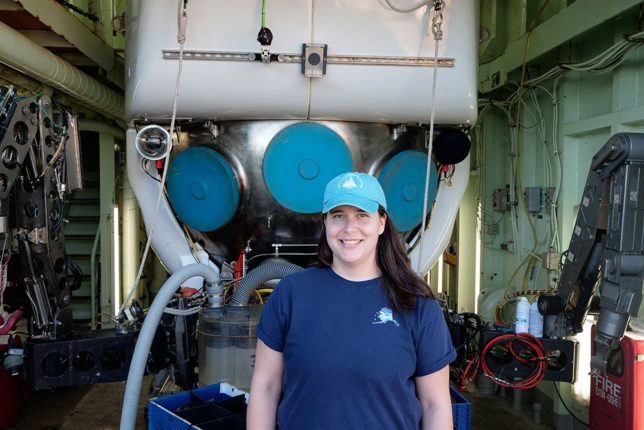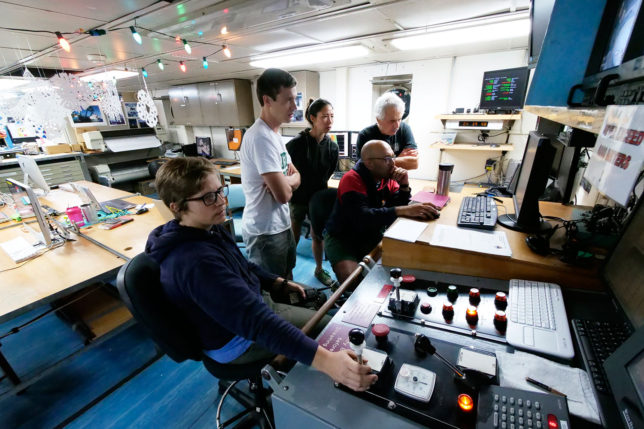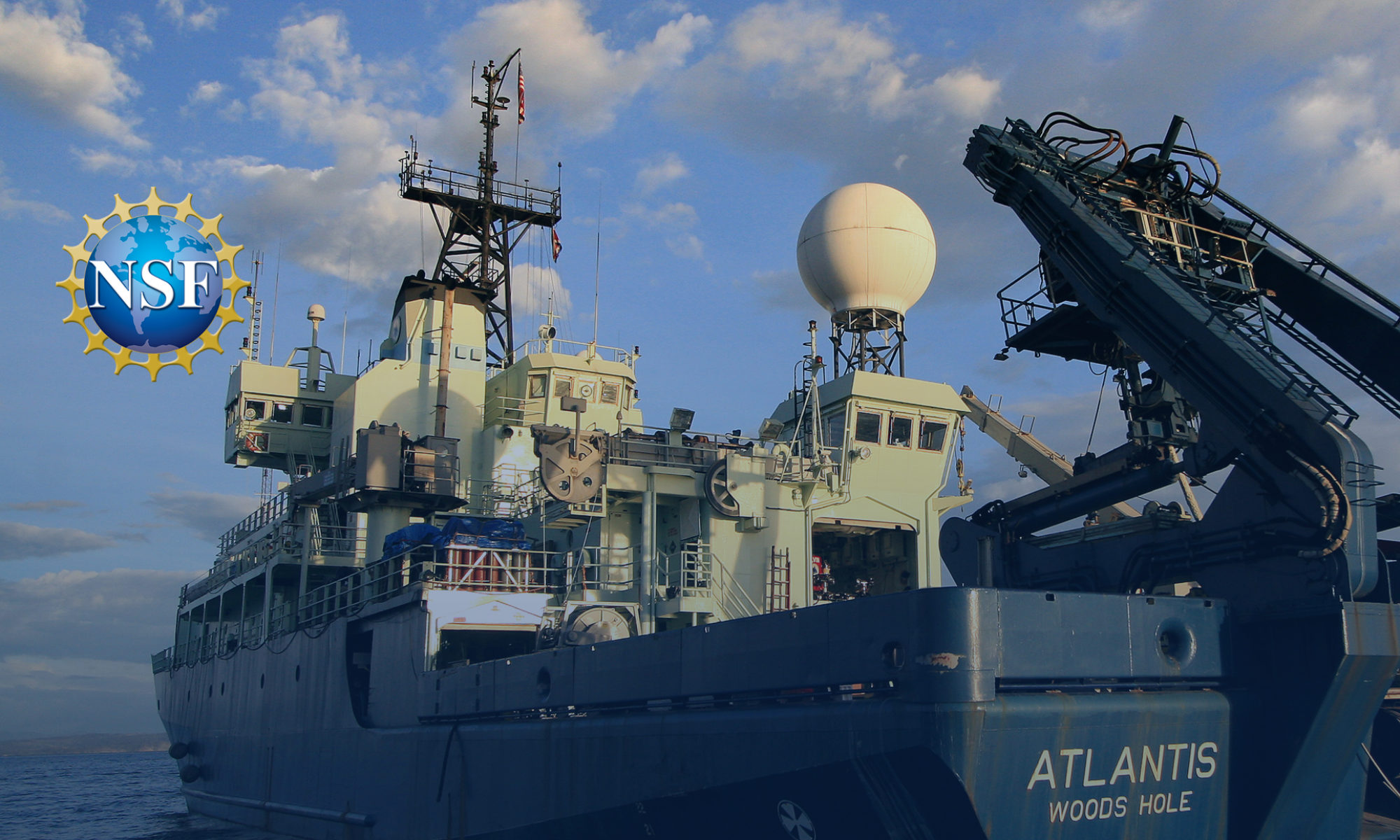
Post by: Elizabeth Trembath-Reichert, Woods Hole Oceanographic Institution/ Arizona State University
Friends on shore have been asking me, “How many people are on the ship with you?” Well the answer is 56: there are 22 members of the crew, 20 scientists, two Shipboard Scientific Services Group (SSSG) technicians, and seven Alvin human-occupied vehicle (HOV) and five Sentry autonomous underwater vehicle (AUV) team members.
Being a part of the collaborative effort this team brings to the mission of doing great science and exploring our oceans and what lies beneath them is one of my favorite parts of being at sea. Below I narrate a bit of “a day in the life aboard the Research Vessel (R/V) Atlantis as co-Chief Scientist preparing for our four Early Career Chief Scientist Training Cruise dives with daily Alvin, Sentry, and CTD operations. You will see everyone on the ship mentioned at least once.
I begin my day peeking out of the black-out curtains of my bunk to confirm it is indeed daytime. I hop out of bed, put on my sea clothes (gym shorts, a t-shirt, and fleece jacket) and head down two decks to the galley to snag easily transportable carbs from breakfast and a cup of coffee. I say Hi to Mark, the cook, who is already busy planning lunch, and make a fresh pot of coffee so that Captain Al doesn’t have to wait around for another pot to brew and can get back to the job of keeping us all safe.
Then I head down one more deck to the main science lab to check in with what has happened while I was sleeping. I see geologists Bobbi, Molly, Mike, Matt, and Valentina happily crushing and examining their rocks recovered from the first four seamount dives of our eight-dive cruise. Mel and Alex, our resident artists, are doing photo shoots of the most glamorous samples.
Microbiologist Heather is refining her microbe traps that we’ll leave on the seafloor until another cruise comes to pick them up next year. Biologist Santiago and microbiologists Rika and Karthik are briefly checking in with the their students and classes, whose final exams are happening while we are at sea. Geophysicists Ross and Aida and Ian from the Sentry team are going through maps to determine the next best Sentry track for tonight.
Todd, the Alvin expedition leader, and Justin, the Sentry expedition leader, both circle through the main lab to check with Dan, the Chief Scientist of the OASIS leg of our cruise, to verify the plan of the day.

I step out into the hallway to cross into the lab inhabited by our geochemists and biologists and see Aton, an oiler, making his rounds checking the temperatures on our ever-important walk-in fridges that allow us to keep samples at bottom seawater temperatures after they come on deck.
Once in the lab, I find biologist Carolyn looking at new specimens on the microscope and geochemists Drew, Dalton, and Alysia setting up the next round of high-temperature fluid samplers, called “majors,” scheduled to go down on Alvin tomorrow. These samplers are critical for getting and preserving the hottest vent fluids to understand the convoluted paths they take from the ocean through the rocky seafloor and back out in vents.
I walk back into the Main Lab and out to the starboard deck and try to stay out of the way of ordinary seamen Patrick and Clindor as they repair and paint spots on the deck that need a little TLC given the heavy use that R/V Atlantis sees daily.

Farther down the deck I see Sean and Manyu testing Sentry, which is back on deck after being down near the seafloor all night making high-resolution maps of where Alvin is currently operating. Farther still, I round a corner and see to the A-frame, a vitally important piece of equipment that lifts the 40,000-pound Alvin in and out of the water every day. Engineers Bobby, JT, Bill and Phil have been working on it daily while Alvin is in the water or we are transiting.
I meet Carolyn and Santiago out on the back deck to layout the ”bioboxes” we hope to use for our dives on the East Pacific Rise. They are both interested in the “charismatic macrofauna” such as the infamous tube worms and crabs that inhabit the hydrothermal vents we will visit and will need these self-sealing boxes to safely bring up creatures from the deep.
I pop up to the bridge with my co-chief Ross to confirm with the third mate Amy on watch what might be a good time to set up an informal science briefing for any interested ship personnel. We swing by the Top Lab to see if the folks down on the seafloor have seen anything interesting so far with the report they are giving every 30 minutes to pilot Mike, who is standing watch as the Surface Controller today.

Is it lunch time? I think its lunch time. We head up to the mess deck to see what Liz, the Steward) and Mark, have in store for us. I step aside to let oiler Corey and wiper Ryan go first since they are going on-shift. After shuffling through the line and doing my best to load up on veggies and fruit before I get to the cookies at the end, I sit down and catch up with where we are in the day and chat with members of the other teams on board. Common topics are sea tales of past cruises and plans after we get to port.
I check my watch and realize I gotta get rid of my tray and plates so I don’t hold up mess attendant Janusz’s turn-around of dishes between meals. We head back down to the main lab to finalize dive planning for tomorrow. Because we have a lot to do on the dive and because only two scientists can go down on each dive, we get crash courses in identifying samples that different teams need, such as biology for geologists and geology for biologists.
All of a sudden, it’s time for the end-of-day science report up in the Top Lab aft of the bridge. Alvin Electrical Lead, Drew, and all-round technician, Rick, patch us down to the sub 2,000 meters below the ship and we get a briefing of what the scientists on today’s dive saw and collected so we can be ready to process samples as quickly and efficiently as possible once they are on deck. The observers, scientists that go down in the sub, are highly complementary of Alvin pilot Jefferson’s care in collecting samples and keeping their precious rocks intact.
Then we scurry back down four decks to our labs to get ready for Alvin’s arrival before going out to watch the sub come back. Meanwhile, the crew is similarly preparing. Ronnie the bosun, who is in charge of directing all the operations on deck, takes in the scene and looks for any potential hazards as the “Alvin swimmers”—communications electronics tech Josh and Alvin tech Nick— don their swimsuits and prepare to jump into the Alvin support boat with able-bodied seaman (AB) Patrick, as AB Jim operates the crane lowering them into the water.
They zoom out to anticipated surfacing location and prepare connect lines to Alvin from the ship and catch a ride back on Alvin once it is on the surface. Meanwhile SSSG technician Allison is preparing to move the A-frame out to collect Alvin. After the sub is safely on deck, the day’s launch coordinator, Danik, directs the biologists and microbiologists waiting in the wings with their hard hats and safety vests it is now safe to get their precious organisms out of the tropical heat and into the cold room near their lab.

Then Alvin goes through its end-of-dive procedure and the observers and pilots emerge victorious from the “ball” to tell tales of what the seafloor had in store for them that day, which always begins with a description of the bioluminescence twinkling outside their windows in the otherwise pitch-black ocean on the way down, and maybe includes a tip that a visit PJ, the chief mate, to get some Dramamine for the bob along the surface during recovery, might not be a bad idea.
Once Alvin is safely secured back in its hanger we can grab the rest of the samples and head to dinner. Meanwhile the Sentry team is preparing for launch so we can maximize bottom time and get as much of the seafloor mapped as possible before Alvin goes down for his next dive tomorrow morning.
After dinner, all stations go into sample processing mode. In the main lab, fluids are filtering and cameras are displaying that day’s video. In the wet lab rocks are being catalogued. In the bio lab alien (to us) creatures from the deep sea are on display as geochemists probe their equally alien fluid compositions. At the same time, those who just dove and those who are about the dive the next day have a meeting with members of the Alvin team.
As Alvin sample processing comes to a close Karthik and Dalton prepare for the night’s CTD casts, working with the bridge and AB Molly, who is operating the winch that lowers the rosette of bottles into the water. Sentry night operator Laura is on watch to make sure the AUV and the CTD stay well away from each other. We use the CTD to send bottles down to the bottom of the seafloor and remotely trigger them from the ship to snap shut at any depth on the way back up. This is allowing our geochemistry and microbiology team to get much higher volumes of water above our hydrothermal vent plumes than we can bring back on Alvin alone. I stay up coloring some souvenir Styrofoam cups to shrink on the next day’s dive while waiting to help them deploy the CTD under the direction of the night shift SSSG, Emily.
After deployment around midnight, I scope out the reports compiled by second mate Max, who is tracking any potential weather we might have to watch out for weeks in advance, and then close my laptop. I say good night to the CTD team who will be up through the night collecting as much water as they can before Sentry needs to come on deck for Alvin to go back down.
As I swing through the mess on my way up to my bunk, oiler Anthony says good morning to me as his day is starting and I say good night as mine is ending.
